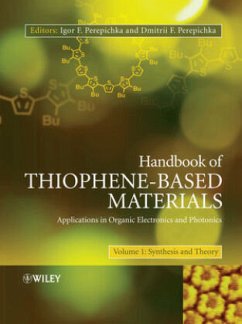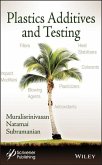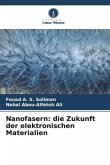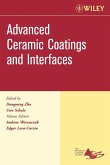Handbook of Thiophene-Based Materials, 2-Volume Set
Applications in Organic Electronics and Photonics
Herausgegeben von Perepichka, Igor F.; Perepichka, Dmitrii F.
Handbook of Thiophene-Based Materials, 2-Volume Set
Applications in Organic Electronics and Photonics
Herausgegeben von Perepichka, Igor F.; Perepichka, Dmitrii F.
- Gebundenes Buch
- Merkliste
- Auf die Merkliste
- Bewerten Bewerten
- Teilen
- Produkt teilen
- Produkterinnerung
- Produkterinnerung
Consisting of a series of critical reviews, written by leading researchers in the field of conjugated polymers and polythiophenes, Thiophene-Based Materials for Organic Electronics and Photonics systematically and comprehensively covers all main aspects of recent academic research and technological applications of thiophene-based materials. This application-oriented book provides a chemists' point of view on the state-of-art and perspectives of the field, and shows students and researchers how the rational molecular design of materials can bring a new breadth to known device applications or…mehr
![Smart Light-Responsive Materials Smart Light-Responsive Materials]() Smart Light-Responsive Materials208,99 €
Smart Light-Responsive Materials208,99 €![Plastics Additives and Testing Plastics Additives and Testing]() Muralisrinivasan Natamai SubramanianPlastics Additives and Testing180,99 €
Muralisrinivasan Natamai SubramanianPlastics Additives and Testing180,99 €![Nanofasern: die Zukunft der elektronischen Materialien Nanofasern: die Zukunft der elektronischen Materialien]() Fouad A. S. SolimanNanofasern: die Zukunft der elektronischen Materialien68,90 €
Fouad A. S. SolimanNanofasern: die Zukunft der elektronischen Materialien68,90 €![Engineering Your Future, 3e Engineering Your Future, 3e]() Stuart G. WaleshEngineering Your Future, 3e69,99 €
Stuart G. WaleshEngineering Your Future, 3e69,99 €![International Conference on Compressors and Their Systems 2005 International Conference on Compressors and Their Systems 2005]() IMechE (Institution of Mechanical Engineers)International Conference on Compressors and Their Systems 2005452,99 €
IMechE (Institution of Mechanical Engineers)International Conference on Compressors and Their Systems 2005452,99 €![Ceramic Coatings CESP V27 Is3 Ceramic Coatings CESP V27 Is3]() Andrew WereszczakCeramic Coatings CESP V27 Is3145,99 €
Andrew WereszczakCeramic Coatings CESP V27 Is3145,99 €![Progress in Advanced Structural and Functional Materials Design Progress in Advanced Structural and Functional Materials Design]() Progress in Advanced Structural and Functional Materials Design74,99 €
Progress in Advanced Structural and Functional Materials Design74,99 €-
-
-
This essential resource consists of a series of critical reviews written by leading scientists, summarising the progress in the field of conjugated thiophene materials. It is an application oriented book, giving a chemists point of view on the state of art and perspectives of the field. While presenting a comprehensive coverage of thiophene based materials and related applications, the aim is to show how the rational molecular design of materials can bring a new breadth to known device applications or even aid the development of novel application concepts. The main topics covered include synthetic methodologies to thiophene based materials (including the chemistry of thiophene, preparation of oligomers and polymerisation approaches) and the structure and physical properties of oligo and polythiophenes (discussion of structural effects on electronic and optical properties). Part of the book is devoted to the optical and semiconducting properties of conjugated thiophene materials for electronics and photonics, and the role of thiophene based materials in nanotechnology.
- Produktdetails
- Verlag: Wiley & Sons
- 1. Auflage
- Seitenzahl: 910
- Erscheinungstermin: 1. September 2009
- Englisch
- Abmessung: 251mm x 196mm x 51mm
- Gewicht: 2452g
- ISBN-13: 9780470057322
- ISBN-10: 0470057327
- Artikelnr.: 26432767
- Verlag: Wiley & Sons
- 1. Auflage
- Seitenzahl: 910
- Erscheinungstermin: 1. September 2009
- Englisch
- Abmessung: 251mm x 196mm x 51mm
- Gewicht: 2452g
- ISBN-13: 9780470057322
- ISBN-10: 0470057327
- Artikelnr.: 26432767
Synthesis and Theory 1 Functional oligothiophene-based materials:
nanoarchitectures and applications Amaresh Mishra, Chang-Qi Ma, José L.
Segura and Peter Bäuerle 1.1 Introduction 1.2 Functionalized
oligothiophenes 1.3 Fused thiophenes 1.4 Macrocyclic thiophenes 1.5
Dendritic and hyperbranched oligothiophenes 1.6 Conclusions and prospects
Acknowledgments References 2 Synthesis, characterization and properties of
regioregular polythiophene-based materials Paul C. Ewbank, Mihaela C.
Stefan, Geneviève Sauvé and Richard D. McCullough 2.1 Introduction 2.2
Consequences of regiochemistry 2.3 Synthesis of regioregular polythiophenes
2.4 Purification and fractionation 2.5 Molecular characterization 2.6
Solid-state studies 2.7 Block copolymers containing regioregular
polythiophenes 2.8 Conclusions References 3 Fused oligothiophenes Peter J.
Skabara 3.1 Introduction 3.2 Synthesis and molecular properties of fused
oligothiophenes 3.3 Conclusion References 4 Thiophene-S,S-dioxides as a
class of electron-deficient materials for electronics and photonics
Giovanna Barbarella and Manuela Melucci 4.1 Introduction 4.2
Electrochemical and photoluminescence properties 4.3 Application in devices
4.4 Conclusion Acknowledgments References 5 Synthesis and properties of
oligo- and polythiophenes containing transition metals Michael O. Wolf 5.1
Introduction 5.2 Transition metal-containing oligothiophenes 5.3
Electropolymerization and properties of polymers 5.4 Conclusion and outlook
References 6 Selenophenes as hetero-analogues of thiophene-based materials
Tetsuo Otsubo and Kazuo Takimiya 6.1 Introduction 6.2 Selenophene-based
conducting materials 6.3 Selenophene-based electroactive materials 6.4
Selenophene-based OFET materials 6.5 Conclusion References 7 Energy gaps
and their control in thiophene-based polymers and oligomers Miklos Kertesz,
Shujiang Yang and Yonghui Tian 7.1 Introduction 7.2 Oligomer vs PBC
calculations of the bandgap 7.3 Gap and connectivity 7.4 Bandgap affected
by an aromatic vs quinonoid valence tautomerism 7.5 Is a small bandgap
thiophene polymer attainable? 7.6 Gaps of ladder-like PThs 7.7
Substitutions and other factors influencing the gap 7.8 Conclusion
Acknowledgment References 8 Theoretical studies on thiophene-containing
compounds Sanjio S. Zade and Michael Bendikov 8.1 Introduction 8.2
HOMO-LUMO gap and bandgap calculations 8.3 Nature of charge carriers 8.4
Effect of substitutions on different properties 8.5 Twisting (inter-ring
deviation from planarity) in oligo- and polythiophene 8.6 IR and Raman
spectra 8.7 UV-Vis spectra 8.8 Quinoid oligothiophene 8.9 Cyclic
oligothiophene 8.10 New compounds with tailor-made properties 8.11
Conclusion Acknowledgments References Volume Two: Properties and
Applications 9 Electrochemistry of oligothiophenes and polythiophenes
Philippe Blanchard, Antonio Cravino and Eric Levillain 9.1 Introduction 9.2
Electrochemistry 9.3 Spectroelectrochemistry 9.4 Conclusion References 10
Novel photonic responses from low-dimensional crystals of
thiophene/phenylene oligomers Hisao Yanagi, Fumio Sasaki, Shunsuke
Kobayashi and Shu Hotta 10.1 Introduction 10.2 Low-dimensional crystals of
thiophene/phenylene co-oligomers 10.3 Amplified spontaneous emission 10.4
Stimulated resonance Raman scattering 10.5 Pulse-shaped emission with time
delay 10.6 Conclusion Acknowledgments References 11 Novel electronic and
photonic properties of thiophene-based oligomers Shu Hotta 11.1
Introduction 11.2 Materials and molecular alignments: thin films and
crystals 11.3 Charge transport: FET device applications 11.4 Photonic
features: laser oscillation 11.5 Implications of the optoelectronic data of
the crystals 11.6 Conclusion and future prospects Acknowledgments
References 12 Liquid crystalline and electroresponsive polythiophenes Kazuo
Akagi 12.1 Introduction 12.2 Synthesis and properties of LC polythiophene
derivatives 12.3 FLC Polythiophene derivatives Acknowledgments References
13 Self-assembly of thiophene-based materials: a scanning tunneling
microscopy perspective Clara Santato, Fabio Cicoira and Federico Rosei 13.1
Introduction 13.2 STM studies of thiophene-based materials 13.3 Conclusions
and perspectives References 14 PEDOT - properties and technical relevance
Knud Reuter, Stephan Kirchmeyer and Andreas Elschner 14.1 Introduction 14.2
Synthesis 14.3 Properties 14.4 Processing 14.5 Uses 14.6 Conclusion
Acknowledgments References 15 Polythiophenes as active electrode materials
for electrochemical capacitors Daniel Bélanger 15.1 Introduction 15.2
Electrochemical capacitors 15.3 Polythiophene derivatives 15.4 Types of
electrochemical capacitors 15.5 Performance and prototypes 15.6 Conclusion
Acknowledgments References 16 Electroactive oligothiophenes and
polythiophenes for organic field effect transistors Antonio Facchetti 16.1
Introduction 16.2 Field effect transistors 16.3 Thiophene-based oligomers
for OFETs 16.4 Thiophene-based polymers for OFETs 16.5 Conclusions and
outlook References 17 Thienothiophene-containing polymers for field effect
transistor applications Iain McCulloch and Martin Heeney 17.1 Introduction
to organic electronics 17.2 Organic field effect transistors 17.3 Organic
semiconductors 17.4 Thienothiophene polymers 17.5 Conclusion References 18
Photovoltaics based on thiophene polymers: a short overview Suren A.
Gevorgyan and Frederik C. Krebs 18.1 Introduction 18.2 Processing at higher
levels 18.3 Thermal processing to alter morphology 18.4 Solvent vapor
treatment to alter morphology 18.5 Thermocleavage 18.6 Other methods to
control morphology 18.7 Conclusion Acknowledgments References 19
Thiophene-based materials for electroluminescent applications Igor F.
Perepichka, Dmitrii F. Perepichka and Hong Meng 19.1 Introduction 19.2
General synthetic routes to PTs 19.3 Thiophene homopolymers 19.4 Thiophene
oligomers 19.5 Copolymers of thiophenes with other conjugated moieties 19.6
Oligomers and polymers with thiophene-S,S-dioxide moiety 19.7 Thiophene
materials for unconventional and advanced electroluminescent applications
19.8 Conclusions Abbreviations References 20 Thiophene-based electrochromic
materials Muge Acik, Michael A. Invernale and Gregory A. Sotzing 20.1
Electrochromism and electrochromics 20.2 Electrochromism in polythiophene
derivatives 20.3 Organic versus inorganic 20.4 Electrochromics in
applications 20.5 Conclusion References 21 Photoresponsive thiophene-based
molecules and materials Luc Ubaghs, David Sud and Neil R. Branda 21.1
Introduction 21.2 Photochromism in single crystals 21.3 Photochromism in
amorphous films 21.4 Photochromism in polymers 21.5 Photochromism on metal
surfaces 21.6 New architectures 21.7 Conclusion References 22 Chemical and
biological sensors based on polythiophenes Hoang-Anh Ho and Mario Leclerc
22.1 Introduction 22.2 Different types of polythiophenes for chemical and
biological sensors 22.3 Chemical sensors 22.4 Biological sensors 22.5
Conclusions References Index
Synthesis and Theory 1 Functional oligothiophene-based materials:
nanoarchitectures and applications Amaresh Mishra, Chang-Qi Ma, José L.
Segura and Peter Bäuerle 1.1 Introduction 1.2 Functionalized
oligothiophenes 1.3 Fused thiophenes 1.4 Macrocyclic thiophenes 1.5
Dendritic and hyperbranched oligothiophenes 1.6 Conclusions and prospects
Acknowledgments References 2 Synthesis, characterization and properties of
regioregular polythiophene-based materials Paul C. Ewbank, Mihaela C.
Stefan, Geneviève Sauvé and Richard D. McCullough 2.1 Introduction 2.2
Consequences of regiochemistry 2.3 Synthesis of regioregular polythiophenes
2.4 Purification and fractionation 2.5 Molecular characterization 2.6
Solid-state studies 2.7 Block copolymers containing regioregular
polythiophenes 2.8 Conclusions References 3 Fused oligothiophenes Peter J.
Skabara 3.1 Introduction 3.2 Synthesis and molecular properties of fused
oligothiophenes 3.3 Conclusion References 4 Thiophene-S,S-dioxides as a
class of electron-deficient materials for electronics and photonics
Giovanna Barbarella and Manuela Melucci 4.1 Introduction 4.2
Electrochemical and photoluminescence properties 4.3 Application in devices
4.4 Conclusion Acknowledgments References 5 Synthesis and properties of
oligo- and polythiophenes containing transition metals Michael O. Wolf 5.1
Introduction 5.2 Transition metal-containing oligothiophenes 5.3
Electropolymerization and properties of polymers 5.4 Conclusion and outlook
References 6 Selenophenes as hetero-analogues of thiophene-based materials
Tetsuo Otsubo and Kazuo Takimiya 6.1 Introduction 6.2 Selenophene-based
conducting materials 6.3 Selenophene-based electroactive materials 6.4
Selenophene-based OFET materials 6.5 Conclusion References 7 Energy gaps
and their control in thiophene-based polymers and oligomers Miklos Kertesz,
Shujiang Yang and Yonghui Tian 7.1 Introduction 7.2 Oligomer vs PBC
calculations of the bandgap 7.3 Gap and connectivity 7.4 Bandgap affected
by an aromatic vs quinonoid valence tautomerism 7.5 Is a small bandgap
thiophene polymer attainable? 7.6 Gaps of ladder-like PThs 7.7
Substitutions and other factors influencing the gap 7.8 Conclusion
Acknowledgment References 8 Theoretical studies on thiophene-containing
compounds Sanjio S. Zade and Michael Bendikov 8.1 Introduction 8.2
HOMO-LUMO gap and bandgap calculations 8.3 Nature of charge carriers 8.4
Effect of substitutions on different properties 8.5 Twisting (inter-ring
deviation from planarity) in oligo- and polythiophene 8.6 IR and Raman
spectra 8.7 UV-Vis spectra 8.8 Quinoid oligothiophene 8.9 Cyclic
oligothiophene 8.10 New compounds with tailor-made properties 8.11
Conclusion Acknowledgments References Volume Two: Properties and
Applications 9 Electrochemistry of oligothiophenes and polythiophenes
Philippe Blanchard, Antonio Cravino and Eric Levillain 9.1 Introduction 9.2
Electrochemistry 9.3 Spectroelectrochemistry 9.4 Conclusion References 10
Novel photonic responses from low-dimensional crystals of
thiophene/phenylene oligomers Hisao Yanagi, Fumio Sasaki, Shunsuke
Kobayashi and Shu Hotta 10.1 Introduction 10.2 Low-dimensional crystals of
thiophene/phenylene co-oligomers 10.3 Amplified spontaneous emission 10.4
Stimulated resonance Raman scattering 10.5 Pulse-shaped emission with time
delay 10.6 Conclusion Acknowledgments References 11 Novel electronic and
photonic properties of thiophene-based oligomers Shu Hotta 11.1
Introduction 11.2 Materials and molecular alignments: thin films and
crystals 11.3 Charge transport: FET device applications 11.4 Photonic
features: laser oscillation 11.5 Implications of the optoelectronic data of
the crystals 11.6 Conclusion and future prospects Acknowledgments
References 12 Liquid crystalline and electroresponsive polythiophenes Kazuo
Akagi 12.1 Introduction 12.2 Synthesis and properties of LC polythiophene
derivatives 12.3 FLC Polythiophene derivatives Acknowledgments References
13 Self-assembly of thiophene-based materials: a scanning tunneling
microscopy perspective Clara Santato, Fabio Cicoira and Federico Rosei 13.1
Introduction 13.2 STM studies of thiophene-based materials 13.3 Conclusions
and perspectives References 14 PEDOT - properties and technical relevance
Knud Reuter, Stephan Kirchmeyer and Andreas Elschner 14.1 Introduction 14.2
Synthesis 14.3 Properties 14.4 Processing 14.5 Uses 14.6 Conclusion
Acknowledgments References 15 Polythiophenes as active electrode materials
for electrochemical capacitors Daniel Bélanger 15.1 Introduction 15.2
Electrochemical capacitors 15.3 Polythiophene derivatives 15.4 Types of
electrochemical capacitors 15.5 Performance and prototypes 15.6 Conclusion
Acknowledgments References 16 Electroactive oligothiophenes and
polythiophenes for organic field effect transistors Antonio Facchetti 16.1
Introduction 16.2 Field effect transistors 16.3 Thiophene-based oligomers
for OFETs 16.4 Thiophene-based polymers for OFETs 16.5 Conclusions and
outlook References 17 Thienothiophene-containing polymers for field effect
transistor applications Iain McCulloch and Martin Heeney 17.1 Introduction
to organic electronics 17.2 Organic field effect transistors 17.3 Organic
semiconductors 17.4 Thienothiophene polymers 17.5 Conclusion References 18
Photovoltaics based on thiophene polymers: a short overview Suren A.
Gevorgyan and Frederik C. Krebs 18.1 Introduction 18.2 Processing at higher
levels 18.3 Thermal processing to alter morphology 18.4 Solvent vapor
treatment to alter morphology 18.5 Thermocleavage 18.6 Other methods to
control morphology 18.7 Conclusion Acknowledgments References 19
Thiophene-based materials for electroluminescent applications Igor F.
Perepichka, Dmitrii F. Perepichka and Hong Meng 19.1 Introduction 19.2
General synthetic routes to PTs 19.3 Thiophene homopolymers 19.4 Thiophene
oligomers 19.5 Copolymers of thiophenes with other conjugated moieties 19.6
Oligomers and polymers with thiophene-S,S-dioxide moiety 19.7 Thiophene
materials for unconventional and advanced electroluminescent applications
19.8 Conclusions Abbreviations References 20 Thiophene-based electrochromic
materials Muge Acik, Michael A. Invernale and Gregory A. Sotzing 20.1
Electrochromism and electrochromics 20.2 Electrochromism in polythiophene
derivatives 20.3 Organic versus inorganic 20.4 Electrochromics in
applications 20.5 Conclusion References 21 Photoresponsive thiophene-based
molecules and materials Luc Ubaghs, David Sud and Neil R. Branda 21.1
Introduction 21.2 Photochromism in single crystals 21.3 Photochromism in
amorphous films 21.4 Photochromism in polymers 21.5 Photochromism on metal
surfaces 21.6 New architectures 21.7 Conclusion References 22 Chemical and
biological sensors based on polythiophenes Hoang-Anh Ho and Mario Leclerc
22.1 Introduction 22.2 Different types of polythiophenes for chemical and
biological sensors 22.3 Chemical sensors 22.4 Biological sensors 22.5
Conclusions References Index








